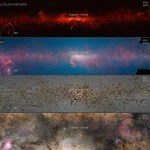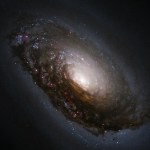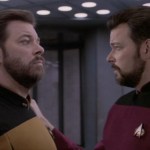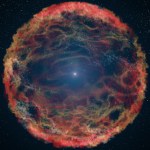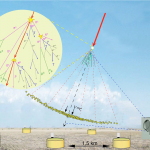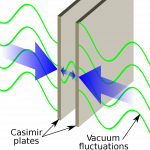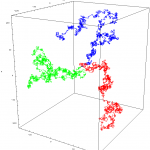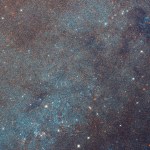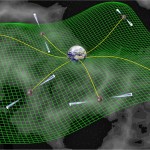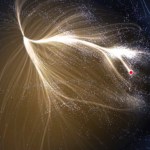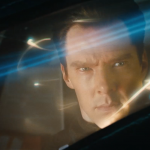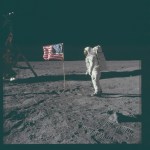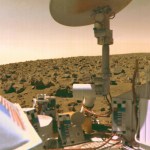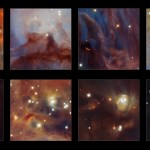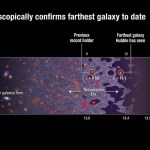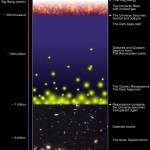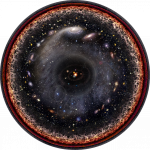
"This suggests a lack of Cepheids in the inner 2.5 kpc region of the Galactic disc except the [Nuclear Stellar Disc]." -N. Matsunaga et al.
If you want to find where all the young stars in a galaxy are, you look for the densest regions of gas and dust: the locations where new stars and star forming regions are most likely to occur. In the Milky Way, like all spirals, we expect this to be in the galactic plane, along the spiral arms, and in the innermost region of the disk and bulge.
A multiwavelength view of the very center of the Milky Way galaxy, including X-ray, visible, infrared and…
"He ate and drank the precious Words,
his Spirit grew robust;
He knew no more that he was poor,
nor that his frame was Dust." -Emily Dickinson
When we look at spiral galaxies, we think of grand arms, star-forming regions and dust lanes lining our perspective. But unlike face-on galaxies, where everything looks the same, galaxies that appear tilted at an angle often appear to have one half far greater in its dust-richness than the other.
The Sunflower Galaxy, Messier 63, tilted relative to our line-of-sight, with one half clearly appearing dustier than the other. Image credit: ESA/Hubble…
“Even though the future seems far away, it is actually beginning right now.” -Mattie Stepanek
It's been a fantastic week here at Starts With A Bang, where we've covered even more ground than normal! First off, for those of you not following me on SoundCloud, we've got a new science podcast out, on the last star in the Universe.
Have a listen and enjoy; that's all possible thanks to the generous donations of our Patreon supporters, as are the re-runs of each article, ad-free, on a 7-day delay over on Medium. Here were the new pieces of this past week:
Will the 'Great Attractor…
"The world you see, nature's greatest and most glorious creation, and the human mind which gazes and wonders at it, and is the most splendid part of it, these are our own everlasting possessions and will remain with us as long as we ourselves remain." -Seneca
Asking where in space the Big Bang happened is like asking where the starting point of Earth’s surface is. There’s no one “point” where it began, unless you’re talking about a point in time. The reality is that, as far as space is concerned, the Big Bang occurred everywhere at once, and we have the evidence to prove it.
Our view of…
“Energy is liberated matter, matter is energy waiting to happen.” –Bill Bryson
When it comes to the Universe, you might think that energy really is only limited by rarity: get enough particles accelerated by enough supermassive, super-energetic sources, and it’s only a matter of time (and flux) before you get one that reaches any arbitrary energy threshold. After all, we’ve got no shortage of, say, supermassive black holes at the hearts of active galaxies.
Galaxy NGC 1275, as imaged by Hubble. Image credit: NASA, ESA, Hubble Heritage (STScI/AURA).
And yes, we do find cosmic rays…
"Another very good test some readers may want to look up... is the Casimir effect, where forces between metal plates in empty space are modified by the presence of virtual particles." -Gordon Kane
If you ask what the zero-point energy of space itself is, you can sum up all of the quantum fluctuations you can that arise in quantum field theory, and arrive at an absurd answer: 120 orders of magnitude greater than the observed. Yet if you assume that there’s an incredible cancellation and you get exactly zero, that removes the one thing our Universe needs to explain its expansion: dark energy.…
"Human beings are strong because we have the ability to change ourselves." Saitama, One Punch Man
The idea of stopping a meteor headed towards our planet with nothing but a superpowered human being sounds like a physical impossibility. But if you had a powerful enough, strong enough, fast enough human, it could be done, so long as you obeyed the laws of physics and conserved energy and momentum.
A map of the asteroid population by size. There are approximately a few million potential "10"s on the Torino scale, over 50 million potential "9"s and nearly a billion estimated potential "8"s…
"Dimension regulated the general scale of the work, so that the parts may all tell and be effective." -Vitruvius
In a four-dimensional Universe (3 space and 1 time), it’s easy to get lost. If you take a random walk, the chances of you coming back to your original starting point in a finite number of steps gets lower and lower the more dimensions you have. If all you could do was walk along a sheet of paper -- or even better, along the surface of a pipe -- you’d have a much greater chance of return than if you had all three spatial dimensions to deal with.
Isotropic random walk on the…
“He who would search for pearls must dive below.” -John Dryden
If you want to know what types of stars are found all throughout a galaxy, looking at our own simply won't do: too much of it is obscured by the plane and our position within it. But there's an even more impressive galaxy -- Andromeda -- just 2.5 million light years away. And thanks to the power of the Hubble Space Telescope, we've not only resolved individual stars within it, we've resolved over a hundred million of them.
Closeup of a large region of the Andromeda galaxy's disk, containing hundreds of open star clusters (…
“Even though the future seems far away, it is actually beginning right now.” -Mattie Stepanek
After another tremendous week here at Starts With A Bang, including one where I recorded a new podcast (look for it later this week on SoundCloud), it's time to take a look back and review all that we've been through. From last Saturday through the past Friday, here's what we saw:
Are there different types of time and space? (for Ask Ethan),
Deepest view of the Orion nebula reveals shocking discoveries (for Mostly Mute Monday),
Forty years ago, we landed on Mars... and found…
"We detect motion along this axis, but right now our data cannot state as strongly as we'd like whether the clusters are coming or going." -Alexander Kashlinsky
When dark energy was discovered, and the expansion of the Universe was shown to be accelerating, there was concurrently another puzzle that received much less attention: the problem of the Great Attractor. Galaxies appear to move due to both the Hubble expansion and the local gravitational field, but the gravity from the galaxies we saw didn’t account for all the motion.
The "flows" of galaxies mapped out with the mass field nearby.…
“‘Star Trek’ says that it has not all happened, it has not all been discovered, that tomorrow can be as challenging and adventurous as any time man has ever lived.” –Gene Roddenberry
Today marks the 50th anniversary of the premiere of Star Trek, our first science fiction adventure that promised a positive view of the future, ushered in by technology and humanity's best traits. In addition to a utopia where maladies like hunger, disease and poverty were eradicated, Star Trek promised a future where technology was widely available and sufficiently advanced to the benefit of all of humanity…
"For me the best answer is not in words but in measurements." -Elena Aprile
If you want to find dark matter directly, your best hope is to gather a tremendous number of nucleons for it to interact with, wait an incredibly long period of time, and devise a device surrounding it capable of detecting even a single potential collision while distinguishing it from any background signals. That was the exact idea behind LUX, the Large Underground Xenon detector.
A diagram of the LUX detector. Image credit: LUX Collaboration, diagram by David Taylor, James White and Carlos Faham.
After a 20…
“I knew I was alone in a way that no earthling has ever been before.” -Michael Collins
Less than a decade after the first human was launched into space, astronauts Neil Armstrong, Buzz Aldrin and Michael Collins journeyed from the Earth to the Moon. For the first time, human beings descended down to the lunar surface, opened the hatch, and walked outside. Humanity had departed Earth and set foot onto another world.
Buzz Aldrin having just planted the first American flag on the surface of a world other than our own. Image credit: NASA/Apollo 11.
While Armstrong and Aldrin walked on the…
"This suggests a robust biological response. These analyses support the interpretation that the Viking LR experiment did detect extant microbial life on Mars." -Bianciardi, Miller, Straat and Levin
On July 20, 1976, the Viking 1 lander touched down onto the Martian surface, followed just a few weeks later by Viking 2. On board both landers were a suite of three experiments designed to look for signs of life.
NASA Viking Lander Biological Experiment Package. Image credit: NASA.
While the Gas Chromatograph-Mass Spectrometer and the Gas Exchange experiment both came back negative, the Labeled…
"...innumerable stars, thousands of double and multiple systems, clusters in one blaze with their tens of thousands of stars, and the nebulae amazing us by the strangeness of their forms and the incomprehensibility of their nature, till at last, from the limit of our senses, even these thin and airy phantoms vanish in the distance." -Mary Fairfax Greig Somerville
When you look at an active, massive star-forming region like the Orion Nebula, you expect to find new stars dominating, blowing off the gas and eventually bringing the episode of star formation to an end. Previous visible light…
“We called the new quark the “charmed quark” because we were pleased, and fascinated by the symmetry it brought to the subnuclear world. “Charm” also means a “a magical device to avert evil,” and in 1970 it was realized that the old three quark theory ran into very serious problems.” -Sheldon Glashow
It's been another fascinating week here at Starts With A Bang, with a focus ranging from the very, very smallest subatomic particles to dwarf planets, stars, nebulae, dark energy and even the Multiverse! Plus, with all the fascinating news of what's going on in our Solar System, I had…
“A human being is part of a whole, called by us the Universe, a part limited in time and space. He experiences himself, his thoughts and feelings, as something separated from the rest a kind of optical delusion of his consciousness. This delusion is a kind of prison for us, restricting us to our personal desires and to affection for a few persons nearest us. Our task must be to free ourselves from this prison by widening our circles of compassion to embrace all living creatures and the whole of nature in its beauty.” -Albert Einstein
If you're talking to someone across the same room, what the…
“Dwell on the beauty of life. Watch the stars, and see yourself running with them.” -Marcus Aurelius
Let there be light! You’d think that would be enough: that you form stars in the Universe, you see those stars in the Universe, and that tells you about what’s out there. If only it were that simple.
The dark nebula Barnard 68, now known to be a molecular cloud called a Bok globule. Image credit: ESO, via http://www.eso.org/public/images/eso0102a/.
In order to truly see the first stars, you need a lot more that just starlight: you need that light to be able to freely travel through space.…
"Go, then. There are other worlds than these." -Stephen King
We think of the Universe as all there ever is, was or will be. But, in fact, there's a limit to the most distant galaxies, stars, matter and radiation we can see. The hot Big Bang occurred a finite amount of time ago, and hence the amount of the Universe accessible to us through any observational means is necessarily limited.
Artist’s logarithmic scale conception of the observable universe. Image credit: Wikipedia user Pablo Carlos Budassi.
What lies beyond that? According to our best explanations and theories, there's more…
